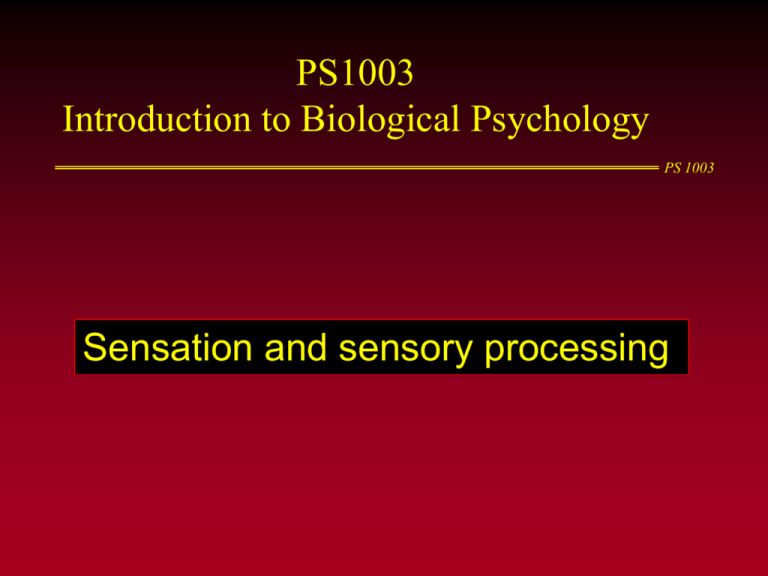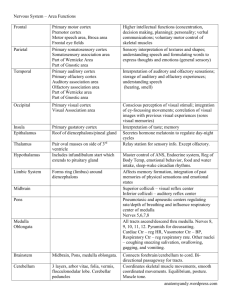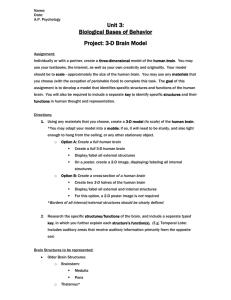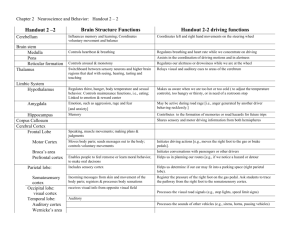PS1003(4) Sensory processing 1 (W)
advertisement

PS1003 Introduction to Biological Psychology PS 1003 Sensation and sensory processing Organisation of sensory systems PS 1003 Peripheral sensory receptors [ Spinal cord ] Sensory thalamus Primary sensory cortex Unimodal association cortex Multimodal association cortex The senses PS 1003 Touch Sight Hearing Taste Smell Sense Skin Eye Ear Tongue Nose Organ Spinal cord Optic II Vestibulo- Facial VII Olfactory cochlear Glossoph. I VIII IX Vagus X Visual Auditory Somatosensory Somatosensory Olfactory Nerve Cortex Gustatory (taste) perception PS 1003 Taste • Salty, sour, sweet, bitter, umani Taste map? – different areas of the tongue sensitive to different tastes • Myth! All tastes are perceived over the full sensory area of the tongue. Gustatory pathway PS 1003 Taste buds Taste receptor cells Touch, pain receptors Facial (VII), Glosso-pharangeal (IX), Vagus (X) Brainstem Thalamus Taste centres of somatosensory cortex Somatosensory cortex Gustatory pathway (2) PS 1003 Olfactory perception PS 1003 Olfactory receptors in olfactory epithelium of nose Olfactory nerve (II) Olfactory bulb Olfactory cortex Hypothalamus Hierarchical processing PS 1003 Sensory processing is organised in a hierarchical manner • Different areas for specific function • Similar in all sensory modalities STS Superior temporal sulcus TEO Inferior temporal cortex • Visual system is a good example TE Inferior temporal cortex Dorsal stream V5 Superior colliculus Eye Dorsal LGN Ventral stream V1 Striate Cortex Posterior parietal Cx V3 V3A STS V2 V4 TEO Extrastriate Cortex TE Inferior Temporal Cortex Area V1 PS 1003 Primary visual cortex (striate cortex) • First level of input to the visual cortex • Cells in V1 respond differently to different aspects of the visual signal (e.g. orientation, size, colour) • Involved in characterisation not analysis o Sends independent outputs to several other areas • Damage to V1 leads to total or partial blindness depending on the extent of the damage Blindsight • Subjects are blind due to damage to area V1 • But can “guess” direction of travel of a moving object or colour • Movement and colour not analysed in V1 • Information can bi-pass V1 to reach visual cortex Area V3 PS 1003 First stage of building of object form Code for component aspects of the object • e.g. edges, orientation, spatial frequency (= size) Feeds information to V4, V5, TEO, TE, STS and to parietal cortex Area V4 PS 1003 Colour recognition • Individual neurones in V4 respond to a variety of wavelengths PET studies show • Activation in V4 to coloured patterns, but not to greyscale Achromatopsia • damage to V4 causes an inability to perceive colour • patients “see the world in black and white” • also an inability to imagine or remember colour Temporal lobe (TEO, TE, STS) PS 1003 Highest level of processing of visual information Recognition of objects dependent on their form • Independent of scale (distance), orientation, illumination. Visual memory Face recognition • Features of a face (subject specific) • Expressions on a face (independent of subject) • Gaze direction Associative visual agnosia • Normal visual acuity, but cannot name what they see Aperceptive visual agnosia Normal visual acuity, but cannot recognise objects visually by shape Area V5 PS 1003 Movement perception • Movement is perceived in area V5 PET studies show • Activation in V5 to moving patterns, but not to stationary ones Middle aged woman, who suffered a stroke causing bilateral damage to the area V5 • became unable to perceive continuous motion • rather saw only separate successive positions • unaffected in colour, perception, object recognition, etc • able to judge movement of tactile or auditory stimuli Posterior parietal cortex PS 1003 Analysis of spatial location of visual cues • Building of an image of multiple objects within space • Coordinates visually directed movement (reaching) • Receives information from all areas of the visual cortex Balint’s syndrome (damage to PPCx) • Optic ataxia • deficit in reaching for objects (misdirected movement) • Ocular apraxia • deficit in visual scanning • difficulty in fixating on an object • unable to perceive the location of an object in space • No difficulty in overall perception or object recognition Summary of hierarchical processing PS 1003 Spatial analysis of visual information Movement recognition Dorsal stream Primary visual input V1 V5 PPCx V3 V3A STS V2 V4 TEO TE Building object form Ventral stream Colour recognition Higher level processing of object form Primary Auditory Pathway PS 1003 Cochlea Ear Vestibulo-cochlear nerve (CN VIII) Cochlear Nucleus Pons Superior Olivary Nucleus Inferior Colliculus Thalamus Medial Geniculate Nucleus Auditory Cortex Cortex Auditory processing PS 1003 Cochlea Cochlear Nucleus Cochlear Nucleus Superior Olivary Nucleus Superior Olivary Nucleus Inferior Colliculus Inferior Colliculus Medial Geniculate Nucleus Auditory Cortex Binaural Cochlea Medial Geniculate Nucleus Auditory Cortex Auditory processing (2) PS 1003 Cochlea PS 1003 Sound waves converted into vibration in basilar membrane Hair cells in organ of Corti transduce movement of basilar membrane into electrical signal • High frequency sound transduced at base • Low frequency sound transduced at apex 20Hz 500Hz Apex 1kHz Base 20kHz 5kHz Information is transmitted along vestibulo-cochlear nerve Auditory processing PS 1003 Originally thought to be in auditory cortex • Intermediate stages only ‘stepping stones’ BUT • Auditory discrimination possible in the absence of auditory cortex (e.g. direction, pitch, tunes) THEREFORE • Initial processing occurs in pons and thalamus • Auditory cortex analyses complex aspects of sound o Dorsal stream (parietal lobe) – spatial analysis o Ventral stream (temporal lobe) – component analysis i.e. Where and What (similar to vision) Localisation of sound PS 1003 Dependent on different characteristics of a sound arriving at each ear Intensity difference • Difference in intensity of the sound between the two ears Latency • Phase shift between the two ears o Due to slightly different distance to reach each ear Duplex theory – sound location depends on a combination of intensity and latency The vestibular organ PS 1003 Semicircular canals: • Detect head rotation and tilt around three axes Head movement Movement of endolymph Displacement of capula Stimulation of hair cells Activation of CN VIII Information transmitted to brain Vestibular pathways PS 1003 Vestibulocochlear nerve (CN VIII) Vestibular nuclei in the brainstem Cerebellum Motor thalamus Cortex Vestibulo-ocular reflex Balance reflex The vestibulo-ocular reflex (VOR) PS 1003 VOR • Works with eyes closed • Not dependent on visual input • Dependent on vestibular input The balance reflex PS 1003 Vestibular organ Inner ear Vestibular nuclei Brainstem Medial Lateral Neck muscles Peripheral muscles Head orientation Postural muscles Balance






